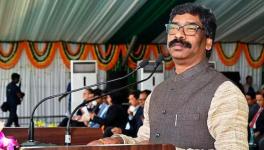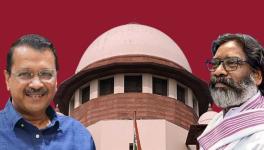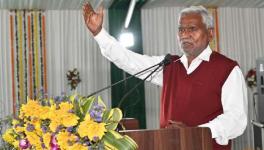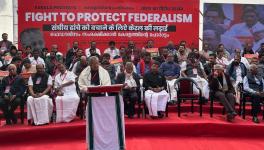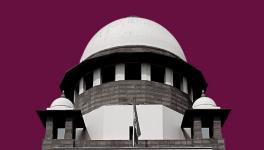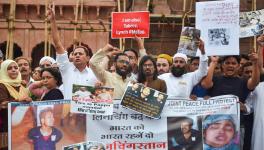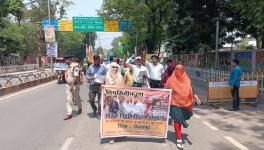Jharkhand’s New Govt Inherits Burden of De-Saffronising
Hemant Soren.Image Courtesy : NDTV
After a very comfortable victory in the Assembly elections, the Jharkhand Mukti Morcha-Congress party coalition led by Hemant Soren has got a challenging journey ahead. Three most pressing tasks demand the ruling dispensation’s immediate attention, the first of which is arresting the de-tribalisation of Jharkhand. This means that the tribes must get the benefits of development and their due share in governance. To achieve this, the new government will have to detoxify the state’s deeply-communalised society.
Saffron forces have been active in Jharkhand for a long time. The state has come to be the nerve centre of lynching. For example, on 11 December, a day before the third phase of the five-phase vote in the Assembly elections, six of the thirteen men accused of lynching Tabrez Ansari six months ago were granted bail by the Ranchi High Court. In this way, lynching and communal agendas continually cast their shadow over everyday life in the state.
Despite the Supreme Court’s guidelines in the Tehseen Poonawala case, the state did not enact a law to protect victims of mob violence and prevent lynching. On 17 July 2018, the apex court had ordered state governments to identify, within three weeks, those districts, sub-divisions and/or villages where lynching and mob violence incidents have recently been reported. “... such time period is sufficient to get the task done in today’s fast world of data collection,” the SC had said. Madhya Pradesh and Rajasthan legislated stringent anti-lynching laws soon after, but the BJP-led regime of Jharkhand, given its long history of saffronising the region (and adjoining Chhattisgarh), did not move a finger.
On 28 June 2018, Harvard-educated BJP leader Jayant Sinha, the sitting parliamentarian from Hazaribagh and a Union Cabinet member at the time, garlanded eight men convicted for the Ramgarh lynching. So this is the situation which the JMM-Congress alliance is dealing with.
The new regime also needs to understand how the process of de-tribalisation worked, and how it went hand-in-hand with saffronisation in Jharkhand for many decades. The sociologist Nandini Sundar, in her essay Teaching to Hate: RSS Pedagogical Programme, details how this de-tribalisation took place in neighbouring Chhattisgarh. The Jharkhand story, however, remains largely untold.
Unrolling the Sangh Narrative in Jharkhand:
In as early as 1952, the Rashtriya Swayamsevak Sangh (RSS) started its Vanvasi Kalyan Ashram project in Jamshedpur, with active help and funding from the adjacent Sarguja princely state of Madhya Pradesh, which now falls in Chhattisgarh. The VKA project has proved to be particularly helpful to the RSS and the Bhartiya Jana Sangh, the precursor of the BJP.
The Vanvasi Ashram, through its Ekal Vidyalayas or single-teacher schools, its satsang centres and other sub-groups, has been engaging in the political “conversion” of tribes into Hinduism. By late 2002, the RSS had already opened about 150 Ekal Vidyalayas across Jharkhand. Today, the Ekal Vidyalaya Foundation runs multiple single-teacher pre-schools in which children are taught basic reading and writing, Sanskrit and ‘sanskars’ or good behaviour.
But the VKA’s most prided initiative is its hostel scheme for teenage tribal boys (there are far fewer for girls) whom they help attend classes V to Class X, and occasionally up to XII. These organisations train the tribals in archery, set up cultural events around archery and other sporting competitions.
For the Dalits, the RSS runs Seva Bharti, an NGO established by its sarsanghchalak or chief Balasaheb Deoras in 1979. Its well-oiled machinery and dedicated cadre helped indoctrinate the tribals wide and deep; a process that spread over many years.
Kailashpati Mishra (1923-2012), an RSS Pracharak from Buxar in Bihar, contributed to saffronising Jharkhand’s tribes, particularly by playing an instrumental role in ensuring that RL Nanda became Vice Chancellor of Ranchi University. Nanda helped the RSS penetrate among the Adivasis. When, in April 1979, violence broke out in Jamshedpur, Mishra was state finance minister. By the 1990s, he was the recognised saffron icon in Bihar.
The background of this riot is particularly striking: In March 1964, Jamshedpur had seen a previous round of rioting. After that riot, many Muslims had settled on lands sold off by the Adivasis in parts of Jamshedpur such as Sabirnagar. This brought the Muslims closer to Adivasi localities such as Dimnabasti. In 1979, there was a strong insistence that for the first time the Ramnavmi procession (taken out on the day Hindus mark the birth anniversary of the god Rama) would be led through Sabirnagar. Thus ensued what was essentially a fight between the tribes and the Muslims.
The RSS-affiliated Hindi daily Ranchi Express (RE) was launched in 1963 as a four-page weekly headed by Sitaram Maroo. Later, RE became a daily. It, too, instigated the violence of April 1979, as the Justice Jitendra Narain report records. Essentially, the liberal journalism of Prabhat Khabar and Hindustan resisted communal politics at the time. On being exposed and discredited, RE gave way to Dainik Jagran. Jagran, in recent decades, has taken up the cudgel of communalising Jharkhand and Bihar.
With all these networks in place, Sangh outfits have been communalising rural as well as urban social spaces of Jharkhand. Consider Jamshedpur (Tatanagar), the state’s largest city with a population of 13.50 lakh including the Adityapur and Gamharia suburbs. It has three Assembly seats out of which one is reserved for the tribes. The RSS is running a chain of schools across the city—in Birsanagar since 1991, in Bahulia since 2018, as also in Baharagora, Bagbera and Chandil.
These facts provide a context to understand the BJP’s continued hold on the urban seats of Jamshedpur.
JMM, the biggest party for tribal interests, never won Jamshedpur:
This is because immigrants (“dikus”) populate this industrial city. The BJP has its support base among mostly elite-caste Hindus and the upper crust of other backward classes or OBCs; the immigrants in Jamshedpur confirm to these social identities. Moreover, Muslims in Jamshedpur also offer a certain degree of economic competitiveness and rivalry in the retail trade segment. This can be gauged in parts of Jamshedpur, such as Sakchi, a small retail trading centre. Almost 15% of the traders here are Muslim. In fact, within Sakchi market is Mohammedan Line, which further illustrates the point.
Another spot, Bistupur, is a posh market zone of Jamshedpur. At least 7% of its traders are, it is often estimated, Muslim. Jugsalai, near the Tatanagar Railway Station has a sizeable proportion of Muslims, again engaged in retail trade. Adityapur and Gamharia are centres of ancillary industrial manufacturing where Muslims are employed as labourers in considerable proportion. Besides, Muslims make up a large number of the city’s auto and taxi drivers, painters, masons, tyre repairmen, motor mechanics, welders, and so on.
Some younger Muslim men have taken up jobs in Gulf countries as well, and they bring home a new, quite visible, affluence—brightly-lit, beautiful and large mosques and a newfound exhibitionism during religious rituals and festivities. A revivalism, a rise in minority communalism, also accompanies these tendencies. In such circumstances, the Hindutva forces find it simpler to communalise the Hindu masses. They capitalise on the relative deprivation of the Hindus of the corresponding class, who often still reside in the immediate vicinity of the gentrifying Muslims.
Who gets elected and what laws they push:
In 1996, Nitish Bharadwaj, who played the Hindu god Krishna in the TV serial based on the epic Mahabharata was elected Lok Sabha Member of Parliament from Jamshedpur. Another BJS-BJP leader, Dinanath Pandey (1934-2019), was continuously elected, from 1977 to 1990, as a member of the Legislative Assembly of Bihar. During the April 1979 Muslim-Adivasi riots, he was accused of participating in specific acts of incitement. Preceding the violence was also an incendiary public speech, delivered by Deoras.
As in the clashes of 1979 in Jamshedpur, the 2002 pogrom in Gujarat had also mobilised the Adivasis against the Muslims. The Justice Tewatia Commission report on the Gujarat riots, Facts Speak for Themselves: Godhra and After, Part II, notes: “Earlier, in Gujarat, tribals never got involved in the Hindu-Muslim riots.” Further, a 2006 report by the human rights organisation, People’s Union for Civil Liberties or PUCL notes how the VKA resorted to de-tribalisation: They “targeted the tribal belts of the country to see that Adivasis lose their identity, culture and traditions of worshipping nature, by asserting that they are Hindus.”
Then, in 2001, the Babulal Marandi government proposed a bill to consider 1932 land records as the base to decide the issue of Adivasi and Moolvasi versus Dikus (immigrants). In the same year, the Ranchi High Court struck down this law. Later, 1986 was taken as the base year. That is, whosoever had been living in Jharkhand since 1986 would be treated as a domicile. This politics of demography proved very helpful to the BJP.
All this has been exacerbated by the corporate-Hindutva nexus. For instance, Ratan Tata has held at least two meetings with current RSS chief Mohan Bhagwat in the last three years. This one in 2016 was widely reported. Such interactions of the RSS with the corporate sector should not be ignored or considered insignificant. For instance, the Tatas have earmarked a substantial part of their Corporate Social Responsibility (CSR) fund for RSS-run projects. Not only this, 75% of the donation received by the BJP has come from the Tata Group’s Progressive Electoral Trust.
Countering the counter-narrative:
As seen above, Jharkhand was on the verge of becoming another “laboratory of Hindutva”, after Gujarat. Struggles against communalisation on such a wide and deep scale are extremely difficult to launch.
The despondency of Mamta Devi, the Congress candidate from the Ramgarh seat, says it all. When asked during the just-concluded election campaign why the “secular” parties are silent on lynching, she said, “We are not raising the issue now... Ek jaati vishesh pe yeh log thoda se bhramit kar dete hain antim charan main jis se vote convert ho jate hai turant.”
What she is saying is that her opponents in the BJP mislead people, causing voters to swing against her party in an instant, towards the end of the election campaign. Mamta Devi further said that her party will talk about mob lynching—‘moment dekh kar ke’—when the time is right. “Yeh log Hindu-Muslim kar detey hain, bus yehi vajah se—the BJP turns it into a Hindu-Muslim issue, that is why we don’t talk about mob lynching,” she said.
Welfare and economic programmes:
It will take a sincere economic programme and a welfare-oriented government to reorient the political economy on which communalism thrives. Therefore, the new government of Jharkhand, if it wants to replace Hindutva, will have to work to mitigate malnourishment and its stark consequence—hunger deaths of poor malnourished adults and children, particularly in the state’s badly nutrition-deficient and poorly-governed West Singbhum district.
Overall, 46.5% of Jharkhand’s population is poor but 60% of its tribals and dalits are poor. The National Family Health Survey-IV (2015-16) reveals that 48% of Jharkhand’s population is in the lowest wealth quintile. These issues need to be addressed with sincerity.
Yet another central issue is the Pathalgarhi Movement in the Khunti region between Ranchi and Jamshedpur. The new regime will need to be sensitive and considerate towards this movement. Dropping the sedition charges against 10,000-odd people of this movement is the most urgent task to be accomplished. Land and forest rights of the tribes need to be respected, as per the Fifth Schedule of the Constitution. That would ensure undoing of the de-tribalisation that was unleashed by the saffron regime. Tribal angst against the BJP was so high that its non-tribal chief minister, Raghubar Das lost his seat by a big margin. This was his sixth consecutive election in the state since 1995, and his first loss, and he could only garner 33% of the votes this time.
The mandate unseating the BJP regime should be seized as an opportunity to launch massive and comprehensive de-communalisation, in a manner that can emerge a model for the rest of India. The gigantic task of detoxifying the communalised masses is an extremely difficult task as of now. Hemant Soren must legislate an anti-lynching law; as one way to retrieve pluralist-secular India. Possibly, this would help formulate a programme and strategy for the forthcoming elections in Bihar in 2020.
The author is professor of modern history at Aligarh Muslim University. The views are personal.
Get the latest reports & analysis with people's perspective on Protests, movements & deep analytical videos, discussions of the current affairs in your Telegram app. Subscribe to NewsClick's Telegram channel & get Real-Time updates on stories, as they get published on our website.











